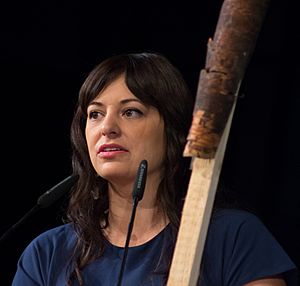Candice Hopkins facts for kids
Quick facts for kids
Candice Hopkins
|
|
|---|---|
 |
|
| Born | 1977 (age 48–49) Whitehorse, Yukon, Canada
|
| Nationality | Carcross/Tagish First Nation |
| Alma mater | Bard College (MA, 2003) |
| Known for | Curator, writer, researcher |
| Spouse(s) | Raven Chacon |
Candice Hopkins was born in 1977. She is a talented curator, writer, and researcher from the Carcross/Tagish First Nation. She focuses on art created by Indigenous peoples. Currently, she is the executive director and chief curator at the Forge Project in New York.
Contents
Early Life and Education
Candice Hopkins was born in 1977 in Whitehorse, Yukon, Canada. She is a member of the Carcross/Tagish First Nation. Candice grew up in Whitehorse and Fort St. John, British Columbia.
Learning About Art and Culture
Candice studied art at the Alberta University of Art in Calgary, Alberta, graduating in 1999. She also spent a year studying at the University of Birmingham in England. After her studies, she worked with the Treaty 8 Tribal Association and the Native Friendship Centre.
This led her to an amazing 8-month internship in Suva, Fiji. She worked with Wainimate, an organization that helps recover Indigenous knowledge about traditional medicine. This experience changed her path. Instead of becoming an artist, she became interested in curating, which means organizing art exhibitions.
Advanced Studies and Early Career
Candice went on to earn her master's degree in curatorial studies from the Center for Curatorial Studies, Bard College in 2003. To pay for her education, she worked as a horse trainer on her family's ranch and as a lab technician.
From 2000 to 2005, she worked at The Banff Centre. There, she was an Aboriginal Curatorial Fellow at the Walter Phillips Gallery. She organized some of her first art projects and exhibitions. She was also mentored by important people like curator Lee-Ann Martin.
Candice Hopkins as a Curator
Candice Hopkins is well-known for her work as a curator. She helps choose and arrange art for exhibitions. She has worked on many big art shows around the world.
Major Exhibitions and Biennials
In 2018, she was a co-curator for the SITE Santa Fe biennial, an art event that happens every two years. She was also a senior curator for the Toronto Biennial of Art in 2019 and 2021.
Candice was part of the team for the Canadian Pavilion at the 58th Venice Biennale. This is a very famous international art exhibition. She also helped curate documenta 14, a huge art show held in Germany and Greece. For documenta 14, she featured works by many artists, including Rebecca Belmore and Britta Marakatt-Labba.
Important Curatorial Roles
Candice has held important curatorial jobs at places like the Walter Phillips Gallery, the National Gallery of Canada, and The Institute of American Indian Arts Museum of Contemporary Native Arts in Santa Fe, New Mexico. Her work has been recognized with awards, including the 2015 Hnatyshyn Foundation Award for Curatorial Excellence in Contemporary Art.
Writing and Ideas
Candice Hopkins is also a talented writer. She shares her ideas about art and Indigenous culture in essays and articles.
Exploring Important Topics
Her essays often discuss important topics. For example, she wrote "The Appropriation Debates" for Mousse magazine. She also wrote "Outlawed Social Life," which was about the ban on the potlatch ceremony and the art of Beau Dick. The potlatch was a traditional gift-giving feast of Indigenous peoples that was once outlawed.
In 2016, she helped organize the School of Listening in Germany. This was a summer program for students from different cities. She also wrote a touching article called "An Elegy for Annie Pootoogook (1969–2016)" after the artist Annie Pootoogook passed away.
Connecting History and Art
In 2011, Candice wrote "The Golden Potlatch: Study in Mimesis and Capitalist Desire." In this text, she explored how Indigenous lands, the search for gold, and money were connected during the Klondike Gold Rush.
She has also written about other interesting subjects, like sound and Indigenous ways of teaching. She has interviewed artists and architects, sharing their ideas with a wider audience.
Selected Curatorial Projects
Here are some of the art exhibitions and projects Candice Hopkins has curated:
- Before the Internet: Networks and Art (2007) in Vancouver, Canada
- Close Encounters: The Next 500 Years (2011) in Winnipeg, Canada
- Sakahàn: International Indigenous Art (2013) at the National Gallery of Canada
- Unsettled Landscapes: SITELINES (2014), where she worked with a team of curators.
- documenta 14 (2017) in Germany and Greece
- 2018 Sitelines Biennial (2018) at SITE Santa Fe
- 58th Venice Biennial (2019), Canadian Pavilion
- Soundings: An Exhibition in Five Parts (2020), which she co-curated with Dylan Robinson. This exhibition featured new art that explored questions about sound and Indigenous art. It traveled to different locations.
- Indian Theater: Native Performance, Art, and Self-Determination since 1969 (2023) at the Hessel Museum of Art in New York.

